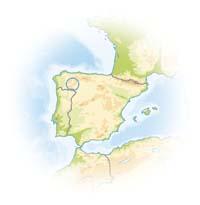The Jellyfish: the strength of gold

The site Las Medulas, south of the province of León, was the largest gold mine in the Roman Empire. This is due to the characteristic aspect of the environment.
The technique used for gold extraction was Ruin montium. First, they brought water to department stores in the mountains of the area, through a wide network of channels. This water was abruptly inserted into the galleries that were made on the ground and the mountain, of soft material, was exploited due to the pressure of the water and the air trapped in the gallery. The soil thus detached was cleaned with water and gold was obtained.
That brutal exploitation of gold lasted only 200 years. And the pastoralism of the later centuries has ended and the landscape has naturalized. At present it seems that the red summits of almost 100 meters high are their own.

These summits are formed by red conglomerates that, in addition to gold, contain silver, iron and borax, among others. The origin of these red clusters is unknown. The main theory is that these are accumulated sediments after the formation of the sedimentary basin of the Bierzo, but there are also indications that they are sediments transported to this place by a large river before the creation of the basin.
The mysterious geological origin, human history and the curious forms that have remained today give a special charm to the place of the Jellyfish. Perhaps that is why Unesco declared a World Heritage Site.
Buletina
Bidali zure helbide elektronikoa eta jaso asteroko buletina zure sarrera-ontzian











